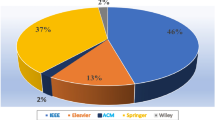Abstract
Data center networks are typically characterized by high density communication components that process and exchange large amount of information using shortest paths. Mostly, data centers network topologies contain multi-rooted tree with multiple equal cost shortest paths between pairs of hosts. Usually, data center networks operation is based on the result of shortest path algorithms and per-flow static hashing which may cause poor network utilization rates with some links becoming congested while some parts of the network are underused. This work presents a flow scheduling algorithm that exploits the path diversity in data center topologies and dynamically reroutes large flows through less congested shortest and non-shortest paths based on the current state of the network without causing packets reordering. The algorithm aims to minimize flows latency while maximizing the network utilization rates. Results show that the algorithm proposed in this work reduces flows completion time by 13–24% over Equal-Cost Multi-Path routing, while improving the average network utilization by up to 10%.



Similar content being viewed by others
References
Al-Fares, M., Loukissas, A., & Vahdat, A. (2008). A scalable, commodity data center network architecture. In ACM SIGCOMM computer communication review (Vol. 38, pp. 63–74). ACM.
Al-Fares, M., Radhakrishnan, S., Raghavan, B., Huang, N., & Vahdat, A. (2010). Hedera: Dynamic flow scheduling for data center networks. NSDI, 10, 19–19.
Amaral, P., Pinto, P. F., Bernardo, L., & Silva, F. (2017). SDN based traffic engineering without optimization: A centrality based approach. In ICC (pp. 1–7). IEEE.
Benson, T., Akella, A., & Maltz, D. A. (2010). Network traffic characteristics of data centers in the wild. In Proceedings of the 10th ACM SIGCOMM conference on internet measurement (pp. 267–280). ACM.
Benson, T., Anand, A., Akella, A., & Zhang, M. (2009). Understanding data center traffic characteristics. In Proceedings of the 1st ACM workshop on research on enterprise networking (pp. 65–72). ACM.
Bertsekas, D. P. (1991). Linear network optimization: Algorithms and codes. Cambridge: MIT Press.
Curtis, A. R., Kim, W., & Yalagandula, P. (2011). Mahout: Low-overhead datacenter traffic management using end-host-based elephant detection. In INFOCOM (pp. 1629–1637). IEEE.
Dolev, S., Elovici, Y., & Puzis, R. (2010). Routing betweenness centrality. J. ACM, 57(4), 25.
Hafeez, T., Ahmed, N., Ahmed, B., & Malik, A. W. (2018). Detection and mitigation of congestion in SDN enabled data center networks: A survey. IEEE Access, 6, 1730–1740.
Hopps, C. E. (2000). Analysis of an equal-cost multi-path algorithm. RFC 2992, Internet Engineering Task Force.
Kandula, S., Katabi, D., Sinha, S., & Berger, A. (2007). Dynamic load balancing without packet reordering. ACM SIGCOMM Computer Communication Review, 37(2), 51–62.
Kandula, S., Sengupta, S., Greenberg, A., Patel, P., & Chaiken, R. (2009). The nature of data center traffic: Measurements & analysis. In Proceedings of the 9th ACM SIGCOMM conference on internet measurement (pp. 202–208). ACM.
Kim, J., Dally, W. J., Scott, S., & Abts, D. (2008). Technology-driven, highly-scalable dragonfly topology. In International symposium on computer architecture (pp. 77–88). IEEE.
McKeown, N., Anderson, T., Balakrishnan, H., Parulkar, G., Peterson, L., Rexford, J., et al. (2008). Openflow: enabling innovation in campus networks. ACM SIGCOMM Computer Communication Review, 38(2), 69–74.
Shpiner, A., Haramaty, Z., Eliad, S., Zdornov, V., Gafni, B., & Zahavi, E. (2017). Dragonfly+: Low cost topology for scaling datacenters. In HiPINEB (pp. 1–8). IEEE.
Tso, F. P., Hamilton, G., Weber, R., Perkins, C. S., & Pezaros, D. P. (2013). Longer is better: Exploiting path diversity in data center networks. In ICDCS (pp. 430–439). IEEE.
Wang, P., Trimponias, G., Xu, H., & Geng, Y. (2019). Luopan: Sampling-based load balancing in data center networks. IEEE Transactions on Parallel and Distributed Systems, 30(1), 133–145.
Zhang, J., Yu, F. R., Wang, S., Huang, T., Liu, Z., & Liu, Y. (2018). Load balancing in data center networks: A survey. IEEE Communications Surveys and Tutorials, 20(3), 2324–2352.
Author information
Authors and Affiliations
Corresponding author
Ethics declarations
Conflict of interest
On behalf of all authors, the corresponding author states that there is no conflict of interest.
Additional information
Publisher's Note
Springer Nature remains neutral with regard to jurisdictional claims in published maps and institutional affiliations.
The work on this paper has been partially supported by Israeli Innovation Authority.
Rights and permissions
About this article
Cite this article
Levi, C., Segal, M. Avoiding bottlenecks in networks by short paths. Telecommun Syst 76, 491–503 (2021). https://doi.org/10.1007/s11235-020-00720-7
Accepted:
Published:
Issue Date:
DOI: https://doi.org/10.1007/s11235-020-00720-7




